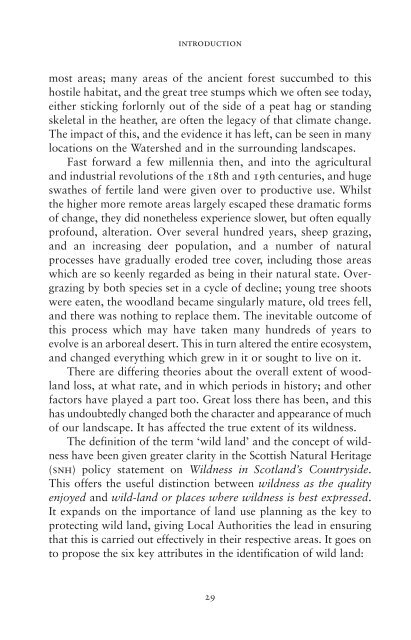Ribbon of Wilderness by Peter Wright sampler
If you’ve bagged the Munros, done the Caledonian Challenge and walked the West Highland Way, this is your next conquest. The Watershed of Scotland is a line that separates east from west; that divides those river basin areas which drain towards the North Sea from those which flow west into the Atlantic Ocean on the other. It’s a line that meanders from Peel Fell on the English border all the way to the top at Duncansby Head, near John O’ Groats – over 745 miles, through almost every kind of terrain. The Watershed follows the high ground, and offers wide vistas down major river valleys, towards towns and communities, into the heartlands of Scotland. Walk the Watershed in eight weeks Tackle short sections over a weekend 7 route maps Over 30 colour photographs Ribbon of Wildness provides a vivid introduction to this geographic and landscape feature, which has hitherto been largely unknown. The rock, bog, forest, moor and mountain are all testament to the Watershed’s richly varied natural state. The evolving kaleidoscope of changing vistas, wide panoramas, ever-present wildlife, and the vagaries of the weather, are delightfully described on this great journey of discovery.
If you’ve bagged the Munros, done the Caledonian Challenge and walked the West Highland Way, this is your next conquest.
The Watershed of Scotland is a line that separates east from west; that divides those river basin areas which drain towards the North Sea from those which flow west into the Atlantic Ocean on the other. It’s a line that meanders from Peel Fell on the English border all the way to the top at Duncansby Head, near John O’ Groats – over 745 miles, through almost every kind of terrain. The Watershed follows the high ground, and offers wide vistas down major river valleys, towards towns and communities, into the heartlands of Scotland.
Walk the Watershed in eight weeks
Tackle short sections over a weekend
7 route maps
Over 30 colour photographs
Ribbon of Wildness provides a vivid introduction to this geographic and landscape feature, which has hitherto been largely unknown. The rock, bog, forest, moor and mountain are all testament to the Watershed’s richly varied natural state. The evolving kaleidoscope of changing vistas, wide panoramas, ever-present wildlife, and the vagaries of the weather, are delightfully described on this great journey of discovery.
You also want an ePaper? Increase the reach of your titles
YUMPU automatically turns print PDFs into web optimized ePapers that Google loves.
<strong>Ribbon</strong>s <strong>of</strong> Wildness_2016_Layout 1 24/05/2016 19:26 Page 29<br />
introduction<br />
most areas; many areas <strong>of</strong> the ancient forest succumbed to this<br />
hostile habitat, and the great tree stumps which we <strong>of</strong>ten see today,<br />
either sticking forlornly out <strong>of</strong> the side <strong>of</strong> a peat hag or standing<br />
skeletal in the heather, are <strong>of</strong>ten the legacy <strong>of</strong> that climate change.<br />
The impact <strong>of</strong> this, and the evidence it has left, can be seen in many<br />
locations on the Watershed and in the surrounding landscapes.<br />
Fast forward a few millennia then, and into the agricultural<br />
and industrial revolutions <strong>of</strong> the 18th and 19th centuries, and huge<br />
swathes <strong>of</strong> fertile land were given over to productive use. Whilst<br />
the higher more remote areas largely escaped these dramatic forms<br />
<strong>of</strong> change, they did nonetheless experience slower, but <strong>of</strong>ten equally<br />
pr<strong>of</strong>ound, alteration. Over several hundred years, sheep grazing,<br />
and an increasing deer population, and a number <strong>of</strong> natural<br />
processes have gradually eroded tree cover, including those areas<br />
which are so keenly regarded as being in their natural state. Over -<br />
grazing <strong>by</strong> both species set in a cycle <strong>of</strong> decline; young tree shoots<br />
were eaten, the woodland became singularly mature, old trees fell,<br />
and there was nothing to replace them. The inevitable outcome <strong>of</strong><br />
this process which may have taken many hundreds <strong>of</strong> years to<br />
evolve is an arboreal desert. This in turn altered the entire ecosystem,<br />
and changed everything which grew in it or sought to live on it.<br />
There are differing theories about the overall extent <strong>of</strong> wood -<br />
land loss, at what rate, and in which periods in history; and other<br />
factors have played a part too. Great loss there has been, and this<br />
has undoubtedly changed both the character and appearance <strong>of</strong> much<br />
<strong>of</strong> our landscape. It has affected the true extent <strong>of</strong> its wildness.<br />
The definition <strong>of</strong> the term ‘wild land’ and the concept <strong>of</strong> wild -<br />
ness have been given greater clarity in the Scottish Natural Heritage<br />
(snh) policy statement on Wildness in Scotland’s Country side.<br />
This <strong>of</strong>fers the useful distinction between wildness as the quality<br />
enjoyed and wild-land or places where wildness is best expressed.<br />
It expands on the importance <strong>of</strong> land use planning as the key to<br />
protecting wild land, giving Local Authorities the lead in ensuring<br />
that this is carried out effectively in their respective areas. It goes on<br />
to propose the six key attributes in the identification <strong>of</strong> wild land:<br />
29


















